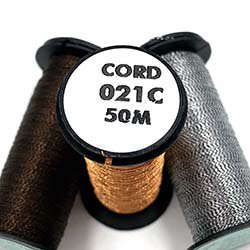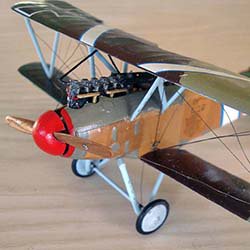Rod-Wrapping Metallics
Beautifully shiny, strong, smooth and colorful metallic for decorating custom rods.
-
Cord for another hobby: model airplanes
It began as an email to Kreinik from model plane builder Rob Stewart. He wrote, "I just bought four rolls of your metallic threads "cord" size. I build scale plastic models of WW1 era aircraft and I thought the threads would be perfect for some detailing in engine wires, cockpit parts, and rigging wires, etc. In order to recommend these to fellow WW1 model enthusiasts, I would like to know roughly what diameter these threads come in..."
When we emailed the information to Rob, it started a wonderful conversation about model aircraft, the tiny threads you need to accurately replicate details, and a needlework connection.
"There is quite a large community of modelers, building in different scales, and different thread sizes would have different applications for many people," Rob told us. Colors like 011C Nickel, 021C Copper, and 001C Silver in Kreinik Cord realistically replicate certain wires and cables.
Rob ended up making a WWI "Eduard 1/48 Fokker EV Weekend Edition" model airplane with a little help from Kreinik metallic Cord (for aileron and rudder cables), and wrote about it here: http://www.internetmodeler.com/artman/publish/aviation/ . He also made a "Fokker Eindekker" with the threads and shared photos here: http://www.wwi-models.org/Fokker-E-V-Weekend-Edition.php Images/StewartR/CP/index.html So we found out metallic threads are perfect for replicating aileron and rudder cables, plug wires and rigging, among other various parts. Since we didn't know a lot about model airplane making, but were extremely impressed at the detailed work and use of our threads, Rob volunteered to make us a model. We contacted Jeff at Rare-Plane Detective who had an EDUARD 8036 Albatros D.III Weekend Edition model plane kit. Rob built the model for us and we are excited to share photos here. See if you can spot the Kreinik threads — threads so familiar in stitching techniques and fishing rod-wrapping are marvelous micro-threads to model makers.
(blog post originally published August 2010)
-
Rod Widgren's rod wrapping tips
By Rod Widgren
Of course, there are many things that make the average rod exceptional. None are more important than the quality of the components that you use; mediocre parts yield mediocre rods. The best components and materials put the task of producing an exceptional rod on the shoulders of the builders.
Always looking for the finest rod building materials, my wife Lee and myself attended the Fly Tackle Dealer Show in Denver, Colorado, many years ago and met the Kreinik brothers. Seeing the quality and the finer diameter of the thread they offered excited me. In the past, the only metallic thread available was a coarse and heavy thread with very little strength. Here at last was Kreinik Cord, a rod-wrapping metallic with a fine diameter and a strong inner core. The finer thread lets me wrap thinner trim wraps (only three wraps of thread) thus decreasing the length of the metallic trim wrap itself. The wrap length is always a concern because most other rod wrapping threads change color when varnish or epoxy is applied. Kreinik Cord, however, does not change color or intensity with the application of the finishing varnish or epoxy.
Metallic Wrapping Threads give just a glint of pizzazz to a somewhat boring surface. The hard part is the balance of just enough sparkle without being too flashy or gaudy. Kreinik offers an array of colors for the custom rod builder that one could match just about any main thread wrap with a complementary metallic thread.
Here are several tips on trim wraps that will make the job easier and reduce the frustration factor:
- Treat the trim wraps exactly like the the main guide wrap, except only shorter. Don’t think of it as something so difficult that it can’t be done; remember that you want to build the best rod, and you want it to look its best.
- Don’t cut the tag end of the trim like you would the main wrap. Use the tag end to pull against the other tag end at about a 45-degree angle and this will tighten the wrap (I also like a little more thread tension for trim).
- Don’t burnish the wraps away from the guide, as this will only loosen your trims and force you to start over.
- Use a new scalpel blade to cut the tag ends for your trims. You need a very sharp blade to make a clean cut for your tag end. If you don’t, you’ll end up with a wrap that will have some “fuzz.”
- Cleanliness is critical in producing an exceptional rod. If you’re not careful, the thread will pick up tiny dirt particles and will make the job of applying the varnish or epoxy more difficult.
- Have patience. To set your rod above the masses, you need to take your time. You can’t rush the process; it only leads to disaster.
- Have fun. Some say that wrapping a rod is the tedious and boring part of rod building, but making a special rod for you or someone else is what makes each rod different. To this day, each rod I build gives me a certain satisfaction of making something that will give countless hours of pleasure and enjoyment.
- Use the rod. The most frustrating compliment we receive is that the rod looks too good to use. Don’t forget that these are still fishing rods and they need to be used to be fully appreciated.
Visit https://www.kreinik.com/store/shop-fly-fishing/rod-wrapping-metallics/cord-for-rod-wrapping to see available colors
Note: this is an educational article on the Kreinik web site, not something that can be shipped






